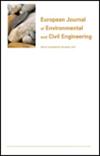加速养护加载速率对含钢棉纤维、建筑垃圾和碱性溶液蒸压加气混凝土力学性能的影响
IF 2.3
4区 工程技术
Q2 ENGINEERING, CIVIL
European Journal of Environmental and Civil Engineering
Pub Date : 2023-11-07
DOI:10.1080/19648189.2023.2276129
引用次数: 0
摘要
摘要本文介绍了一种开发蒸压加气混凝土(AAC)砌块的新方法,研究了不同加载速率对其抗压强度和破坏行为的影响。探索了碱液和加速固化槽固化替代铝粉和粉煤灰蒸压罐固化的方法。以建筑垃圾代替粉煤灰,加入碎钢棉纤维提高砌块强度。在不同加载速率下对砌块进行试验,生成应力-应变图,计算弹性模量。利用ANSYS软件进行仿真对比,验证了分析模型的准确性。研究表明,实验值与模拟值之间存在一定的相关性,证实了CDW和CSWF在AAC区块开发中的成功结合。在测试过程中增加加载速率导致测量的杨氏模量降低,表明应变速率依赖性。然而,加入CSWF通过重新分配应力和抑制裂纹扩展来提高杨氏模量。该研究有助于了解AAC的机械性能和性能,支持其作为砌体材料在结构应用中的可持续替代品的潜力。关键词:蒸压加气混凝土(AAC)短切钢棉纤维(CSWF)建筑垃圾(CDW)加载速率应力-应变图杨氏弹性模量(E)致谢作者要感谢印度梅斯拉市Birla理工学院为实验观察和研究所需的原材料提供种子资金。披露声明作者未报告潜在的利益冲突。数据可用性声明在研究过程中生成或使用的所有数据和模型都出现在提交的文章中。本文章由计算机程序翻译,如有差异,请以英文原文为准。
Effect of loading rate on mechanical properties of autoclaved aerated concrete having steel wool fibres, construction waste and alkaline solution by employing accelerated curing
AbstractThis paper introduces a new method for developing Autoclaved Aerated Concrete (AAC) blocks, investigating the impact of different loading rates on compressive strength and failure behaviour. Alkaline solution and accelerated curing tank curing were explored as alternatives to conventional methods using aluminium powder and autoclave curing with fly ash. Construction and demolition waste was used as a substitute for fly ash, and chopped steel wool fibres were added to enhance block strength. The blocks were tested under various loading rates, and stress–strain graphs were generated to calculate Young’s modulus of elasticity values. ANSYS software was used for simulation and comparison, validating the accuracy of analytical models. The study shows a correlation between experimental and simulated values, confirming the successful incorporation of CDW and CSWF in AAC block development. Increasing the loading rate during testing leads to lower measured Young’s modulus, indicating strain rate dependency. However, including CSWF enhances Young’s modulus by redistributing stress and restraining crack propagation. The research contributes to understanding AAC's mechanical properties and performance, supporting its potential as a sustainable alternative for masonry materials in structural applications.Keywords: Autoclaved aerated concrete (AAC)chopped steel wool fibres (CSWF)construction and demolition waste (CDW)loading ratestress – strain graphyoung’s modulus of elasticity (E) AcknowledgementThe authors would like to acknowledge Birla Institute of Technology Mesra, Ranchi, India, for providing seed funding for the raw materials necessary for experimental observations and research.Disclosure statementNo potential conflict of interest was reported by the author(s).Data availability statementAll data and models generated or used during the study appear in the submitted article.
求助全文
通过发布文献求助,成功后即可免费获取论文全文。
去求助
来源期刊

European Journal of Environmental and Civil Engineering
ENGINEERING, CIVIL-ENGINEERING, GEOLOGICAL
CiteScore
4.80
自引率
4.80%
发文量
153
审稿时长
6 months
期刊介绍:
The European Research Area has now become a reality. The prime objective of the EJECE is to fully document advances in International scientific and technical research in the fields of sustainable construction and soil engineering. In particular regard to the latter, the environmental preservation of natural media (soils and rocks) and the mitigation of soil-related risks are now not only major societal challenges, but they are also the source of scientific and technical developments that could be extremely beneficial.
 求助内容:
求助内容: 应助结果提醒方式:
应助结果提醒方式:


